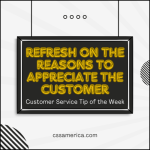
A recent Buffer.com study asked employees who are working remotely due to COVID-19, what was their greatest struggle. While there were many different responses, the Top 2 totaled 40% of the struggles identified – Loneliness and Collaboration/Effective Communication.
When you hear something like this – that individuals working remotely are often lonely or struggling with effective communication and collaboration – you start to wonder how communications can be more effective, how collaboration can occur, and how feelings of loneliness and isolation can be overcome.
As I was thinking about the root causes of these issues and possible solutions, I remembered the Customer Service Standards that one of our education industry clients implemented. We helped to design these Standards based on their desired organizational culture, and I wanted to share them with you.
Paraphrased below are some of the Standards. They are worded as actions, but they are also individual commitments. Review them, and see how you can tangibly address them to care for yourself and your co-workers:
- I will communicate with others so they feel valued and important. I will actively listen to them and convey my understanding, communicating in a clear, concise, and complete manner.
- I will acknowledge communications from others in a timely manner and manage expectations for next steps; I will then address the need in a time that meets or exceeds their expectations.
- I will engage with others around common goals, building mutual trust and loyalty as we move together toward solutions.
- I will work with others, proactively sharing information and ideas to support the achievement of collective goals.
These all relate to communication, collaboration, being proactive, and being responsive. They revolve around a theme of empathy and caring for others. And if utilized, they may help to overcome the loneliness of others…and ourselves.
Apply these Standards to Care for Co-workers during COVID.
Signup for FREE Tips! Contact Us More Resources for You Visit Our Home Page














 I’ve been reading a book recently about a Charlotte-based service company, and the author of the book conveys the CEO’s perspective on management, culture, and serving customers. At the back of the book, the author noted the organization’s Core Values. They are honesty, integrity, fairness, and respect. I literally did a double-take on the pages, because my company’s Core Values are respect, honesty, fairness, and integrity. Yes, the order is different, but the values are the exact same!
I’ve been reading a book recently about a Charlotte-based service company, and the author of the book conveys the CEO’s perspective on management, culture, and serving customers. At the back of the book, the author noted the organization’s Core Values. They are honesty, integrity, fairness, and respect. I literally did a double-take on the pages, because my company’s Core Values are respect, honesty, fairness, and integrity. Yes, the order is different, but the values are the exact same! As a management consultant, oftentimes my job is to identify the key issues, determine the root causes, and provide solutions. We do a lot of strategy work, we conduct many research projects, and we train and train and train our clients. However, improvement usually involves pointing out what needs to be done differently, better, or more or less frequently in order to achieve the best outcomes possible.
As a management consultant, oftentimes my job is to identify the key issues, determine the root causes, and provide solutions. We do a lot of strategy work, we conduct many research projects, and we train and train and train our clients. However, improvement usually involves pointing out what needs to be done differently, better, or more or less frequently in order to achieve the best outcomes possible.






